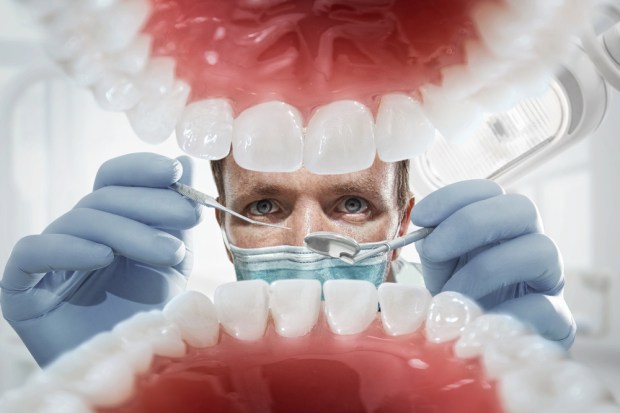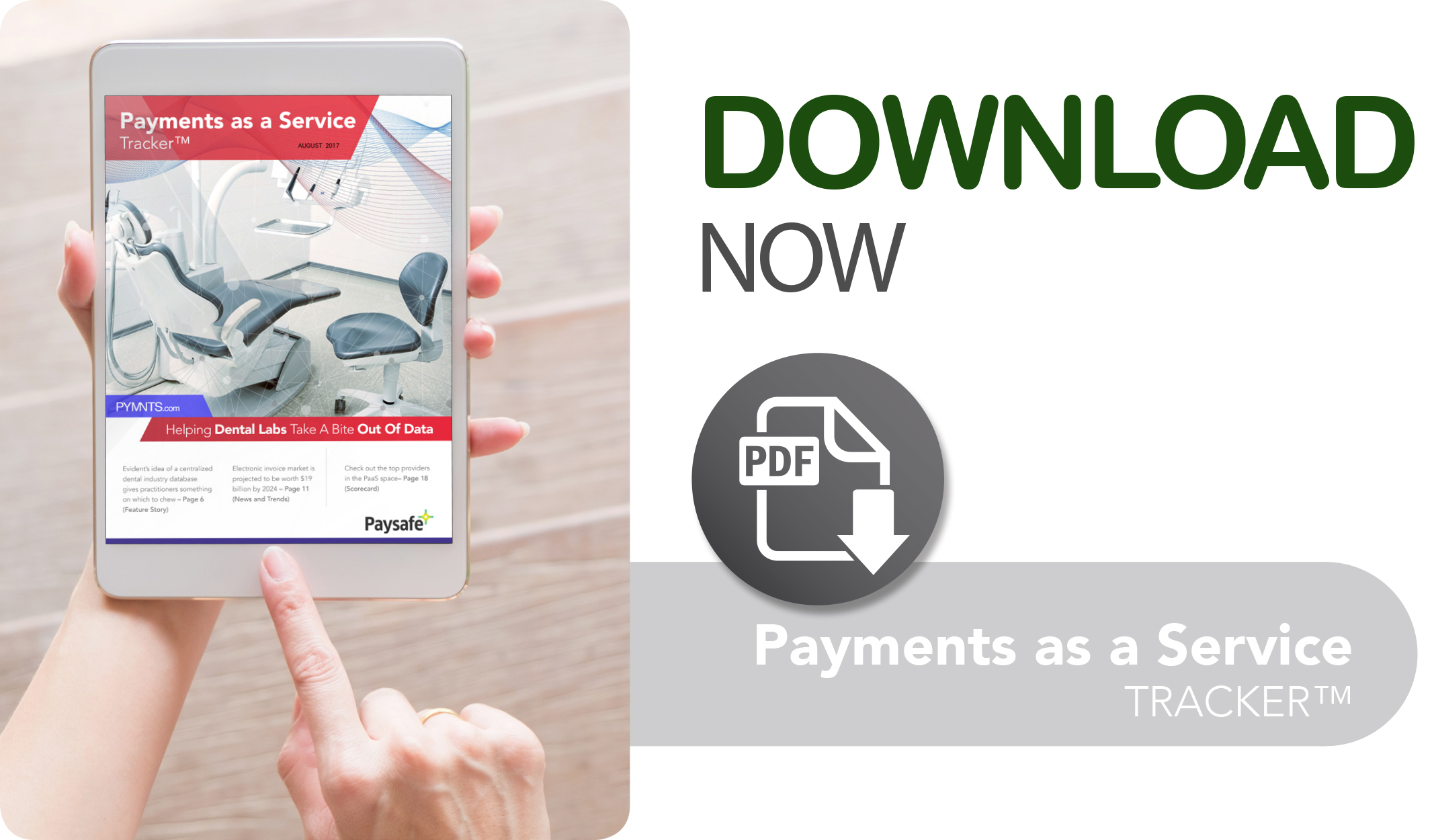Helping Dental Labs Take A Bite Out Of Data

How to get the dental industry aligned on Big Data? Now, that’s something to chew on. In the August PYMNTS Payments as a Service Tracker™, Paolo Kalaw, CEO of dental software solutions provider Evident, explains how payments inside of dental practice management software not only delivers healthy teeth and gums but provides a better payments experience for patients. Plus, the latest headlines from the payments space and over 90 providers in the directory – including five new additions – in the Tracker.
Patients turn to dentists for throbbing toothaches, but where do dentists go to address their own pain points?
To another doctor or dentists, perhaps. But, as it turns out, some of the common pain points for dental practitioners aren’t necessarily their own health issues. Instead, it’s the grind of filing paperwork, managing office operations and accepting and processing payments that creates potential problems.
While dental practitioners have access to software management solutions to help keep their businesses running smoothly — such as those from financial technology provider Dovetail and software company Planet DDS’ cloud dental practice management platform Deticon — those solutions often lack features that could provide broader data insights into treatment and service trends.
That’s something Evident Healthcare Systems, a dental software management provider, is hoping to achieve by creating a centralized resource. The platform will offer data insights to practitioners across the dental care industry.
PYMNTS recently spoke with Evident’s CEO Paolo Kalaw about the company’s efforts to create an industry-wide database focused on guiding dental care toward more effective treatment and services.
Healing payments pain points in the clouds
As of 2016, there were some 196,441 practicing dentists in the U.S., according to the American Dental Association.
According to Kalaw, most of these practitioners operate on the scale of smaller business, often lacking larger accounting and administrative resources. Moreover, a bulk of dental practitioners continue to rely on legacy payment systems which complicate handling of billing and payment information by making it a multi-party task.
“The paper can be touched as much as seven to eight times, from filing to processing to going through an insurance company,” Kalaw said.
He believes the solution to eliminating these payment pain points lies in transferring the capabilities of these legacy systems to the cloud.
Once the data from the legacy systems is transferred to the cloud, Evident’s centralized database maps the necessary data across a host of web-based services, including payment applications. This, Kalaw explained, shows Evident Healthcare’s underlying technology.
Transfer of data to web-based applications, in turn, helps dental clinics reduce their operating costs, he added. For instance, use of automated payment and reconciliation services ensures payments are delivered and matched to the correct patient, tremendously reducing operational costs and scope of error.
“It allows us to leverage the cloud and take something that was roughly $100,000 in capital expense and drop the price down to something like $300 per month for operating,” Kalaw explained.
Taking an ‘apples to apples’ approach for dental data
The use of a central database can extend benefits beyond the potential savings of a cloud-based payment system. Specifically, Kalaw argues, this provides the industry with a cloud-based solution that can help it more easily compare data.
Dental clinics have traditionally operated their own independent platforms hosted on local office servers, an arrangement that allowed dental professionals to map their data in whatever way they saw fit. This means two dental clinics could refer to the same type of treatment differently. This can make tracking the results of a similar procedure across multiple dental practices challenging when sorting through various data sets.
For instance, within the dental community, the definition of a dental remake, which involves replacing a broken tooth, varies from clinic to clinic. According to Kalaw, while some dental practitioners often define a remake as a complete tooth replacement, others define it as repairing a partially fractured tooth. Such variation in definitions can muddle aggregation of data relating to these procedures.
Moreover, the sheer volume of dental procedures performed every day further complicates things. The most recent statistics from the National Association of Dental Plans puts the number of Americans with access to dental insurance at 211.7 million as of 2016. That’s millions of potential data points that need to be aligned to get a more accurate view of the industry, Kalaw explained.
“It becomes very difficult to compare 500 systems with [millions] of patients, each mapped a different way,” he noted.
Evident, as a mobile, AI-based company, is seeking to address that challenge by offering a common mapping system to enable the industry to access more accurate data insights. Kalaw said the company’s database can help the dental industry get on the same page about the efficiency of specific procedures by focusing on mapping the data from various dental clinics into a central dataset.
“If we did a search to find the failure rate of some of these treatments [using our database], we are at least more certain that we’re comparing apples to apples,” Kalaw highlighted.
Better data, better dental service?
Taking an “apples to apples” approach could help the dental care market deliver stronger services to its patients, according to Kalaw. By tracking data trends in the North American dental market, the company aims to offer specific insights into which types of procedures are more likely to be successful.
Last year, the company tracked the dental restorations made from four types of materials by 1,000 dentists in the U.S., the U.K. and Canada. In a whitepaper, Evident reported restorations made from monolithic zirconia material had a lower remake rate of 5.5 percent, whereas porcelain fused to metal had a higher remake rate of 9.5 percent.
Another study looked at the administrative costs dental clinics must absorb to process a payment by paper check. Evident’s research found it costs dental clinics an average of $9 to process a paper check due to handling, administrative, distribution and transaction costs.
Information like this is vital for dental practitioners to provide an improved level of care and operate more cost-effectively, Kalaw noted.
“If we have a universal dataset that we [can] look at, by analyzing that information … [dentists have] the tools to create efficiencies and deliver dental care for the future,” he explained. “Our hope is that as we expand our technology, that we’re able to provide more efficient ways to deliver quality dental care.”
Incentives for building a centralized database
While a centralized database system benefits dental clinics large and small, more data is needed for the concept to succeed, Kalaw emphasized.
To encourage dental office personnel to submit their data and participate in Evident’s program, the company is incentivizing contributions to the database through its loyalty program, EvidentPay Rewards. Much like the loyalty programs of restaurant chains, the rewards program offers points to enrolled clinical staff. The points are redeemable in the form of gift cards from popular merchants like Sephora and Starbucks.
If current trends are any indication, the dental industry is poised to see an influx of new dental patients, which could further contribute to the growth of a centralized database. A recent market report pointed out that an increasingly geriatric population will result in greater demand for dentists. With more people returning to the workforce, many are gaining access to dental insurance benefits and seeking dental care.
For the dental industry, it’s an opportunity to get on the same page about treating patients by seeking common insights into the most effective dental care practices.
. . . . . . . . . . . . . . . .
To download the August edition of the PYMNTS.com Payments as a Service Tracker™, click the button below.
The PYMNTS.com Payments as a Service Tracker™ gives an overview of the trends and activities of merchant platforms that not only enable payment processing of new and old technologies, but also integrate with other features to improve the merchant’s experience, including customer engagement, security, omnichannel retail, analytics, inventory management, software and hardware management and more.

